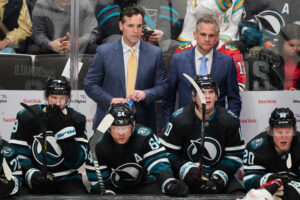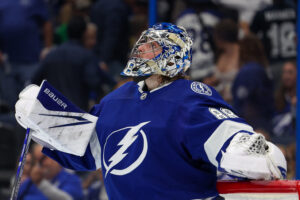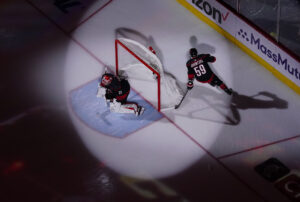Player development seems to always result in more questions than answers. How likely is it for a top pick to pan out? What makes a player a “steal”? Last Word On Hockey will be starting a new series on how to properly develop prospects from all different spots throughout the draft. This week’s piece involves top-15 picks and how they were used early in their careers.
Player Developments Of Top-15 Picks
In the span of 2005 through 2015, there were 21 total selections made between 11th overall and 15th overall on forwards playing in North America. Looking at all 21 forwards, they were split into different categories. Today, we’ll look at the category of “Near NHL-ready when brought in.” That category had three players. Those players were Mikhail Grigorenko, Sven Baertschi, and Michael Grabner. In this piece, we will look at Grabner.
Player Development Of Michael Grabner
Grabner, drafted 14th overall by the Vancouver Canucks in the 2006 NHL draft, came out of the WHL’s Spokane Chiefs. In his DY-1 season, he recorded 13 goals and 11 assists for 24 points in 58 games played. That was good for 0.414 points per game, ranking 17th out of 21 forwards in DY-1 production. He followed that up with 36 goals and 14 assists for 50 points in 67 games with Spokane, which was good for 0.746 points per game. That rate was 19th out of 21 forwards in DY production. Clearly not yet ready, he would return to the WHL after being drafted.
In his DY+1 season with the Chiefs, Grabner would score 39 goals and 16 assists for 55 points in 55 games, which is exactly one point per game. That ranked 15th out of 20 forwards still outside the NHL in DY+1 production. The following season, he would join the AHL with the Manitoba Moose.
Michael Grabner Joins AHL For More Player Development
In 74 AHL games, he scored 22 goals and assists for 44 points, which was 0.595 points per game. That ranked 11th out of 12 forwards outside the NHL in DY+2 production. Again, he would play in the AHL, scoring 30 goals and 18 assists for 48 points in 66 games, for 0.727 points per game. That ranked second out of seven forwards still outside the NHL in DY+3 production.
Now deemed near NHL-ready with success at the AHL level, Grabner would play at the NHL level the following season.
How Was Michael Grabner Used?
Splitting between the AHL and NHL, Grabner would see 38 AHL games, scoring 15 goals and 11 assists for 26 points. At the NHL level, he would play 20 games with five goals and six assists for 11 points, while averaging 13:54 time on ice per game. His analytics were okay, at best, with an even-strength offence goals above replacement (EVO) of 0.1 and an even-strength defence goals above replacement (EVD) of -0.8. With a below replacement level defensive impact, his wins above replacement (WAR) and goals above replacement (GAR) were decent, but not great, at 0.2 and 1.3, respectively.
In his second season, Grabner would be traded to the New York Islanders. He would play exclusively at the NHL level, appearing in 76 NHL games. He would score 34 goals and 18 assists for 52 points while averaging 15:05 time on ice per game. Meanwhile, his analytics were outstanding, with his EVO (10.1) at an outstanding level. Unfortunately, his offensive explosion hurt his defence, with his EVD falling (1.3) by a bit. However, his offensive stats were enough to get his WAR (2.9) and GAR (16.1) were borderline elite.
Michael Grabner Takes A Step Back In Year Three
In his third season, Grabner would play only in the NHL again. This time, he played 78 games, scoring 20 goals and 12 assists for 32 points, averaging 15:33 time on ice per game. His analytics took a massive step back as his counting stats did. His EVO (2.6) dramatically fell, while his EVD (-4.4) was horrible. That led to his WAR (0.1) and GAR (0.5) to barely stay above replacement level.
Following his third season, Grabner would play three more seasons with the Islanders, scoring 36 goals and 24 assists for 60 points in 143 games played. He would join the Toronto Maple Leafs next, for one year, scoring nine goals and assists for 18 points in 80 games. Next, he played for the New York Rangers for one and a half seasons, playing 135 games, scoring 52 goals and 19 assists for 71 points. In his second season with the Rangers, he was dealt halfway through to the New Jersey Devils, where he would finish the season and leave. In total, he played 21 games with two goals and three assists for five points.
Final Seasons And Player Development Round-Up
Joining the Coyotes, he would play two seasons, with 17 goals and 10 assists for 27 points across 87 games. He has not played since his last season with Arizona in 2019-20. Overall, Grabner was never an elite player but had a respectable career. Part of that could be due to a change of scenery from the Canucks to the Islanders. It’s likely he may have bounced from the AHL to the NHL off and on with Vancouver through those first three crucial seasons for a prospect. That said, his player development went well upon joining the Islanders, and that helped carve a long and successful career.
Junior league stats via Elite Prospects, NHL stats via Hockey Reference, NHL analytics via Evolving Hockey






